If all goes as planned, the Air Force this fall will step into what it hopes will prove to be a major expansion of irregular warfare capabilities.
USAF has long possessed unparalleled competence for high-intensity major theater wars. Now, the service wants directly to address problems created by small, unsophisticated insurgencies and other conflicts such as that swirling in Afghanistan.
The effort will comprise advances in aircraft, training, and deployments.
USAF’s IW scheme calls for buying or adapting a variety of new aircraft types, likely to include a small counterinsurgency fighter. Roles of many USAF specialists, ranging from instructor pilots to runway builders, will be broadened and deepened, with an increased emphasis on foreign language and cultural proficiency.
The service will stand up a school to train advisors who can help partner nations build and operate their own air forces.
USAF members on an armed reconnaissance mission outside of Patrol Base Meade, Iraq.
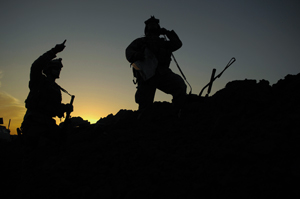
Equally important, the Air Force seeks to sharpen its skills in precision strike and close air support by deploying more combat control airmen with ground forces and by investing in new technologies and hardware.
It will continue to expand and refine its key intelligence-surveillance-reconnaissance capabilities.
Irregular warfare is an often-misunderstood concept. The Defense Department defines IW as “a violent struggle among state and nonstate actors for legitimacy and influence over the relevant populations.”
DOD goes on to say, “IW favors indirect and asymmetric approaches, though it may employ the full range of military and other capacities, in order to erode an adversary’s power, influence, and will.”
It defines “irregular forces” as “armed individuals or groups who are not members of the regular armed forces, police, or other internal security forces.”
The Air Force’s multifaceted IW program should not be regarded as a transformation of the service into a force focused only on counterinsurgency. Far from it. Air Force leaders, rather, see the shifts as expanding a portfolio of skills already possessed by many airmen.
Irregular warfare is “a multidisciplinary activity,” Gen. Norton A. Schwartz, the Air Force Chief of Staff, noted in recent remarks. “The question is: Is there a way to maximize the versatility of … general-purpose assets for us to be better prepared to prosecute the irregular kinds of missions that we face, which include building partner capacity and training others?”
Schwartz, in remarks at a Heritage Foundation event in Washington, D.C., said, “We have entities in the Air Force today that have those combinations of skills.” He was referring to contingency response groups, which comprise a number of specialties, focused on the capacity “to open airfields” for expeditionary forces.
However, “with the right kind of training and language skills, … these existing organizations can also serve to better train others to perform air missions on their own nations’ behalf. And that’s one of the things we decided to do, … to ‘dual-mission’ the existing groups that perform those functions.”
Schwartz had just come from a Corona meeting of top Air Force leaders, at which the way ahead for IW was discussed. The overall IW strategy is to be determined by fall, but in the interim, a number of steps will be taken.
For starters, the Air Force leadership ordered an analysis of alternatives to be done to look at aircraft that meet three different needs: small vertical and fixed wing lift, and light attack. The idea is to evaluate aircraft that could be operated effectively by USAF, but also could be affordable and appropriate for use by a wide variety of partner nations that lack the technical sophistication—or money—to invest in higher-end platforms such as C-130s, F-15s, and F-16s.
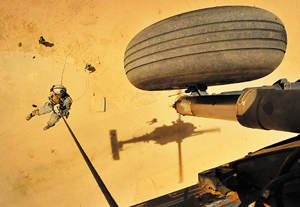 |
SrA. Corey Farr, 66th Expeditionary Rescue Squadron, rappels from an HH-60G Pave Hawk during operational training in Iraq. |
The Key Enablers
Because many IW operating areas won’t be located near airfields, a helicopter is essential, according to Robert S. Day, director of IW requirements for the Air Staff. It is one of the “key enablers” to help work with and build partner nation air forces, particularly “some of the less-governed nations.”
Fixed wing transports will also be looked at, and they will generally be on the smaller side, akin to those employed during the Vietnam War, where small payloads and short runways in remote locations were the rule. Day said the C-27J, which the Air Force will buy to augment its tactical airlift fleet, is considered a “medium mobility” aircraft and too large for the IW requirement.
Finally, a new counterinsurgency airplane—performing “armed overwatch”—will be needed, with the ability to operate from forward or bare-bones areas, having ISR capabilities comparable to those on Predator and Reaper unmanned aircraft, but having crews on board with basic attack skills. Day said he’s seen “more than 60” proposals for such an aircraft, ranging from off-the-shelf designs to modified World War II fighters to all-new concepts. Key factors in reducing the field of candidates will be simplicity and affordability for less technically sophisticated allies.
Air Mobility Command will perform the AOA on the light transport, while Air Combat Command will perform the ones on the helicopter and light strike aircraft. Cost information is to be compiled this summer, to inform early Fiscal 2011 budget plans, and the full AOAs are to be done later this year.
Partners may wish to select platforms from other countries, especially if they’ve already got some investment in, say, Russian designs, Day said, which could complicate USAF acquiring such systems if there are Congressional strictures against buying them.
The MC-12W Liberty Project Aircraft—an ISR aircraft based on the civilian Beechcraft King Air 350 and pushed from concept to battlefield in less than two years—is emblematic of what the Air Force is trying to do with its new aircraft, Day said. Such an aircraft would pose little technical challenge and could be operated by both USAF and partner air forces.
Schwartz said of the new aircraft—“light strike, light lift, and so on …—we won’t be making a huge investment in those areas, … but this is a space that we should probably be in, … with platforms that other nations—nascent, developing nations—might be able to assimilate more easily than some of our higher-end, more sophisticated platforms that we operate with great effect.”
He added that “the idea here is to work our way into this—start small and see where it takes us.”
There is about $694 million planned for investment in Air Force IW capabilities over the next seven years. The bulk of the money will go toward procuring the new light aircraft. The rest will be divided among training initiatives, ISR capabilities, and regional IW centers at Air Force headquarters in Europe, the Pacific, and in Africa.
Schwartz also said he envisions the light strike aircraft as possibly a primary or advanced trainer that could be equipped with light ordnance, such as rockets and small bombs. Air Force instructor pilots would have skills in light attack and counterinsurgency, and they could pass these skills along even as they provided basic flight instruction to partner air force pilots. The instructors could also be deployed to COIN missions themselves.
“That’s what I’m talking about, … trying to think innovatively about how to approach this, in a way that’s manageable both from a manpower and resource perspective,” Schwartz said.
That’s why Schwartz has emphasized folding the IW mission into the existing general-purpose forces: because there simply aren’t—and won’t be—any new infusions of end strength to accommodate new missions.
“Our approach on this will … be to minimize the creation of new organizations,” Schwartz explained. “The idea will be to take elements that have this capability and align them with existing operations groups … to get them the necessary supervision … without creating lots of organizations and … additional overhead that we can’t afford.”
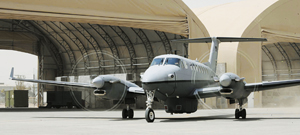 |
The first MC-12W to arrive in-theater taxis out of its hangar at Joint Base Balad, Iraq, on the way to its first combat sortie June 10. ( |
Right-size for Global Demand
In April—before the Corona deliberations—Schwartz gave an address at the Brookings Institution in Washington, D.C., about the Air Force’s role in IW and COIN. He said USAF leadership was considering the possibility of creating an entire wing dedicated to IW. However, Day said the thinking since Corona is toward smaller organizations—groups—but that final decisions haven’t been made.
“We are looking at demand signals that are out there” from regional commanders in chief and air operations centers to gauge what the long-term need for IW capacity will be, Day reported. What the Air Force doesn’t want to do, he said, is create organizations specifically geared to the current fight.
“What we want to do is right-size for the global demand. Because it’s not just Iraq and Afghanistan; it is the globe, and a lot of that is the equator and below,” he noted.
The Air Force’s IW initiative began in 2004, Day said, when “it was myself and a major, and it was all about how the Air Force can defeat the [improvised explosive devices],” which were taking a heavy toll on US combat troops in Iraq.
The Air Force at that time was getting short shrift in joint service discussions of how it could participate in anti-insurgency operations. When a new Army-Marine Corps joint doctrine on IW—authored by Army Gen. David H. Petraeus—premiered in 2007, it carried scant mention of the role of airpower.
“The counterinsurgency manual issued by the Army and Marines is over 200 pages long, and yet only four pages are dedicated to air, space, and cyberspace,” Defense Secretary Robert M. Gates said in an April 2008 speech to the Air War College at Maxwell AFB, Ala.
The speech drew attention because, in it, Gates said it had been “like pulling teeth” to get the military services to move “aggressively … to provide resources needed now on the battlefield.” His remarks were interpreted as a jab at the Air Force for failing to provide enough ISR assets, such as unmanned aircraft, for the wars in Iraq and Afghanistan. Within 40 days of that speech, Gates requested the resignations of the Chief of Staff and Secretary of the Air Force at that time, Gen. T. Michael Moseley and Michael W. Wynne, respectively.
The Air Force had put out its own IW doctrine in August 2007, but with the subsequent decapitation of the Air Force leadership and Gates’ instructions to put far greater emphasis on IW, that doctrine is now considered due for replacement. It was updated in January in a new IW white paper, released at the same time as one on the service’s Global Partnership Strategy, since the two are so closely interrelated, Day said. Both documents carry the signatures of Schwartz and Air Force Secretary Michael B. Donley.
In the Maxwell speech, Gates said he envisioned a “100-wing Air Force of allies and partners” and encouraged his audience to think about “what more we might do—through training and equipping programs or other initiatives—to enhance the air capabilities of other nations.” Gates further noted that USAF would be increasingly called to perform “civil-military or humanitarian operations with interagency and nongovernmental partners and deal directly with local populations. This will put a premium on foreign language and cultural expertise.”
Gates wrapped up his remarks by saying the Air Force needed to “think hard about whether we have the right platforms—whether, for example, low-cost, low-tech alternatives exist to do basic reconnaissance and close air support in an environment where we have total command of the skies, aircraft that our partners can afford and use.”
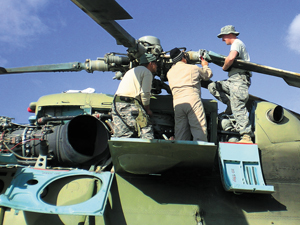 |
TSgt. Dennis Flanagan trains Afghan maintainers on a Russian-made Mi-17 transport helicopter at Kandahar Airfield, Afghanistan. |
The Air Force had anticipated Gates’ direction and had set up an IW Task Force the previous month. It set about pursuing “pathfinder” initiatives to investigate what USAF’s IW role should be and lay out a plan to get there. At the June Corona, it was decided that the Air Force has still not determined what the “end state” of its IW capabilities should be, Day said.
Some things are already clear, however. Day said that the Air Force doesn’t get enough credit for all the things it already brings to IW—mainly because they are so part-and-parcel of what the service does every day.
“These key enablers are so ubiquitous, and we do them habitually, we find [it] hard to even bring them up,” he said.
In a Task Force meeting, he asked the other members to “tell me something the Air Force does that’s not … related to IW.” The only answer that came back was ICBMs, Day reported.
Too many people fail to recognize the foundational aspects of the Air Force’s IW contribution, he said.
Still “All In”
When somebody calls “troops in contact, in a matter of minutes, somebody’s on top, ready to deliver ordnance. That seems fairly easy, but if you go back through everything it takes to deliver it”—GPS satellites, secure communications, mapping, precision ordnance, fighters, tankers to get them there, airlift to resupply them—“that’s a pretty complex task.”
Day echoed a frequent Schwartz comment that “we’ve been ‘all in,’ we are ‘all in,’ and we will be ‘all in.’ We will be as competent at irregular warfare as we are in conventional.” Still, one of the thrusts of the Air Force’s IW plan will be to beef up the number of tactical air control parties deployed with ground forces—to increase their numbers, enhance their skills, and provide them with new equipment.
For example, much of the ground-controller-forces equipment has become “atrophied,” Day said, because aircraft are doing more self-reporting of their positions domestically.
“But when you go overseas, aircraft aren’t necessarily self-reporting, … especially if you’re in a conflict,” he noted. So, the equipment is old, “but the good news is, it may give us the opportunity to replace the equipment … in a smarter way.” He noted that terminal air controllers, ground approach controllers, and en route controllers all have different kinds of radars. They could be equipped with standard “deployable, multifunction radars that simply have a different picture for a different controller,” which would mean a larger buy, easier training, and lower unit costs.
Another problem to correct with the expanded-capability contingency response groups is that they will be more closely aligned with specific ground force units. The CRGs permitted the Air Force to “reach out and grab specialists, pull them together in a team, and put them forward.” However, the benefits of always working with the same people were not available. Now the CRGs will be aligned with specific Army and Marine Corps units so the organizations “get to know each other” and develop “long-term relationships.”
The CRGs involve “a whole litany” of experts, Day said. They will be dual-designated with the task of not only opening new airfields but providing advice to partner countries.
Notionally, one CRG each will be “habitually” aligned with Africa Command and Air Forces Southern. The four remaining in the US will also be for irregular warfare and building partner capacity both.
“Two of those four, we’re going to do what we call IW/BPC-Heavy,” Day said. If it looks like the mission requires “more than we thought, and we need a lot more time here than the few weeks we were thinking of doing, then these heavies can go in and stay maybe six months.”
The Air Force will continuously step up its ability to collect ISR, Schwartz said at Brookings. He acknowledged that avoiding hitting civilians in a counterinsurgency is a relentless challenge, so “what we’re focusing on is to provide the kind of tactical situation awareness that allows our folks both to be successful and be discriminating at the same time.” Although there are rules of engagement which shift in response to changing situations, “my counterparts—and this is certainly true at the COCOM level and at the joint task force level—have little interest in sort of tinkering with the tactics. … We turn it over to the folks who know how to do this well, with an abundance of information that gives us much higher confidence that they’ll act with precision and they’ll be successful.”
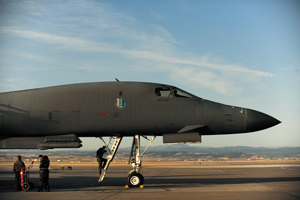 |
Crew members ready a B-1B at Ellsworth AFB, S.D. The aircraft is equipped with a Sniper advanced targeting pod. |
He added that incurring civilian casualties in attacks on “deliberately planned targets” is rare. “The real challenge is spontaneous targeting, … when a call comes through, ‘troops in contact need help now.’” That challenge will require “weapons that you can use discretely, that are precise, as well as scalable in terms of … the effects.” Constant surveillance, he said, will allow the strikers to know “what else is in the blast radius, or the effect radius.” He said USAF will work to better integrate “the intelligence side and the ops side” to further reduce the risk of civilian deaths or injuries.
However, there will be so much information to process that there will have to be more automated ways to do it, Schwartz said. Although the Air Force is “putting more than 4,000 people” into the “back end” of ISR—those who do the analysis and development of actionable knowledge—“that trend line can’t continue. … A major area of endeavor has to be … to apply intelligent systems in a way that allows us to digest that material, to identify intelligence, and distribute that in a much more automated fashion; that’s the only way ahead. … [We] can’t fix that with people.” The Air Force can’t afford to “have information left on the floor.”
A new, dedicated air advisor schoolhouse will be developed by Air Education and Training Command, Day said. The existing schoolhouse is on the Army’s Ft. Dix, N.J., facility, and produces 700 graduates a year. The new school—location yet to be determined—will graduate about 1,500 air advisors a year, but the output will be scalable to match the current “demand signal,” he noted. The school will teach both officers and enlisted how to help partner countries staff, organize, and equip their own air forces, “to help them create their own civil-military air infrastructure.” It will involve “some regional training, … some language training, some social-cultural training.”
A Bureaucratic Labyrinth
Among the Corona findings was that there isn’t the right level of coordination with other federal agencies that will be involved in helping partner countries defeat insurgencies.
“There’s a lack of overall, whole-of-government effort to coordinate BPC [building partner capacity] efforts,” Day noted. “It’s not just Department of Defense; it’s … Commerce, … State, … the judicial arm; it’s everything.”
Combatant commander staffs and air operations center personnel will likely be given additional training in IW and BPC to help their bosses navigate the bureaucratic labyrinth on getting support in those areas.
“It’s like 60 different authorities a combatant commander has to wind his way through to figure out, how do I get money? How do I get it in this year, for this purpose?” Day explained.
Schwartz, in his Brookings remarks, said that the intergovernmental capacity has to be built up, but that the Defense Department usually takes the lead in such matters because “one of the advantages that DOD has—it’s inescapable—is that we have depth, and we have scale … and we also have an organization and people say, yes, sir, or yes, ma’am. So it’s not surprising when, in a pinch, … [when] we need to get something done, that sometimes the spotlight comes toward DOD.”
To face that reality, Schwartz said, “I think what we will end up doing is going to our reserves and relying on [them] for some of those unique civilian skill sets … to make our effort more holistic.” He also said that the State Department is launching an initiative to create its own kind of “civilian reserve corps. … My hunch is that over time, that sort of initiative will proliferate into the other departments of the government.”
In his Brookings remarks, Schwartz said the Air Force’s IW efforts will require a new breed of airman more than just new equipment or organizations.
The service needs to build “people who can do this, who are comfortable in austere settings, [with] families that are prepared to have their loved ones deployed for extended periods, over a matter of years. … It’s entirely possible … that the United States Air Force in some ways will have to be more like the Foreign Service when this is all said and done, and much less the garrison force” of the pre-1990s era.
He added that in IW, it must be recognized that force can be too much the “blunt” instrument, and that the Air Force will increasingly focus on more precision and discrete effects.
At the same time, however, development of the new types of capabilities would stand USAF in good stead for dealing with yet another variety of conflict—“hybrid warfare.” In this type of war, enemies employ both high- and low-tech weapons and tactics simultaneously or in sequence. An example of this came in summer 2006 in Lebanon, when Israel found itself face-to-face with not only lightly armed Hezbollah irregulars but also Hezbollah forces wielding ballistic missiles, cruise missiles, unmanned aerial vehicles, and advanced communications. The Pentagon leadership is convinced that, in the future, these types of wars will be far more common and likely than large force-on-force major combat operations.
All in all, Schwartz maintains, the American way of war has had to change.
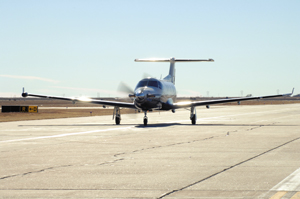 |
PC-12 Pilatus aircraft, such as the one pictured here, are versatile and have the ability to operate on short and unimproved runway surfaces. |
“Sometimes … we have compensated for maybe not being smarter than our adversaries with mass, with capacity. … We won whether we were smart or not. But we’re in an era where … things are much more complicated. … We have to be as skilled and as wise, as well as capable, more capable than our adversaries.”
Day said that “if we’re successful,” his office “will not exist in four years, because irregular warfare will be totally ingrained in the being of the Air Force.”